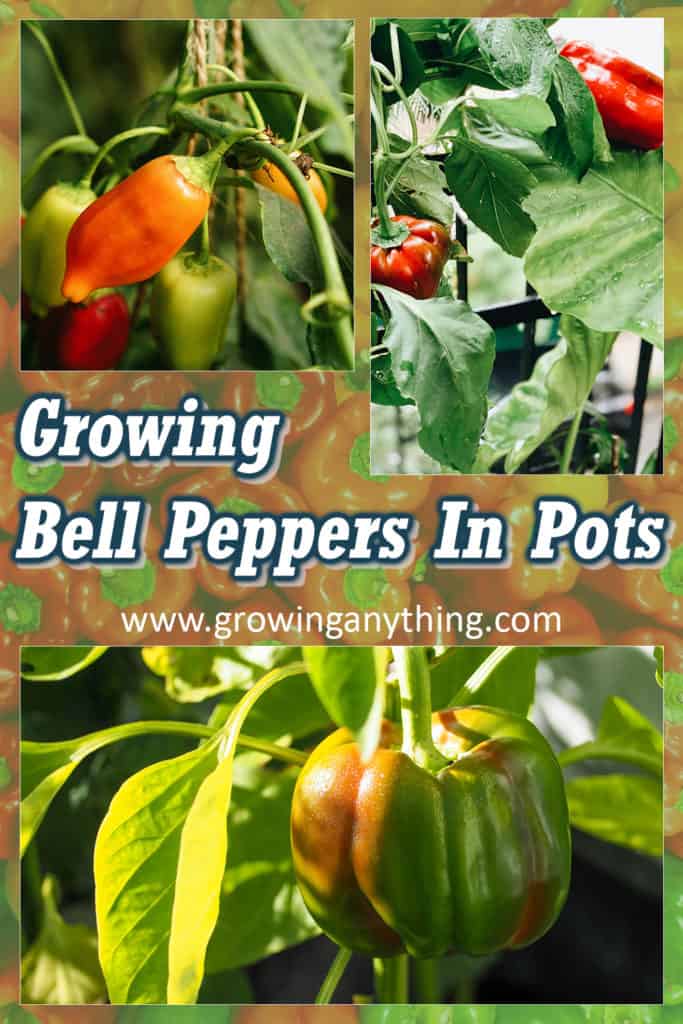How to Grow Bell Peppers In Pots
Did you know that growing bell peppers in pots is not only possible but easy as well? Here is a guide that will help you understand everything about correct pots, sowing bell pepper seeds, and care.
Like tomatoes, bell peppers are technically a fruit. The plant enjoys a warmer temperature and requires some afternoon shade. They don’t need a lot of space, which is why they grow well in pots.
Keep reading to get all the information required for growing bell peppers in pots!
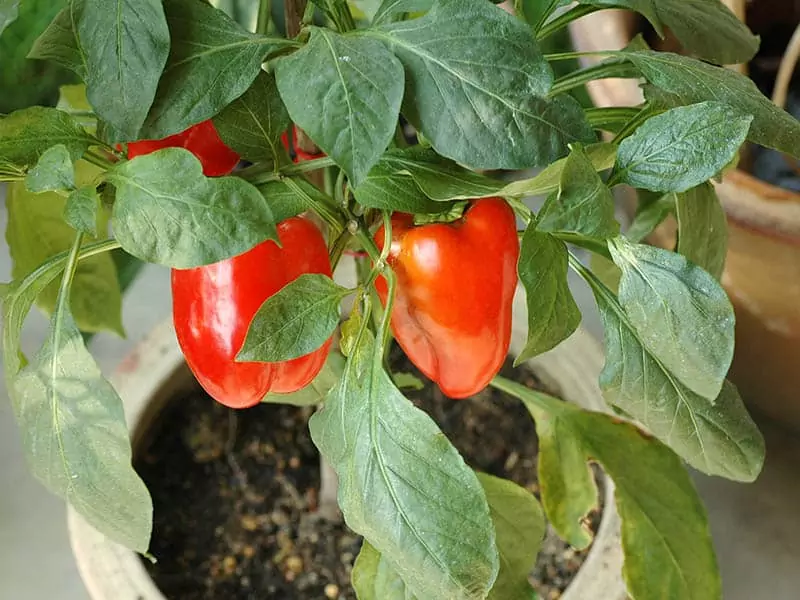
Bell Peppers At a Glance
Before I walk you through the entire process of container gardening for bell pepper plants, let’s discuss a few things. The scientific name of the plant is Capsicum annum.
The plant belongs to a large family which includes more than 2.300 species. It is the same family as tomatoes, potatoes and eggplants.
Bell peppers come in different sizes, colors and shapes, and they are much used in all cuisines around the world. You can prepare them in dishes, eat them raw, throw them in salads and more. So, bell peppers are a versatile plant, which is also good for your health.
These fruits are rich in vitamin C, potassium, folate, and antioxidants. So, include bell peppers in your veggie garden for flavors and health benefits.
Next, did you know that red bell pepper and green bell peppers are the same? Each bell pepper is green when it is young. But if you leave the fruit to mature long enough, it will turn red! Also, with the deeper red color of red pepper, the level of Vitamin C and sweetness increases.
Indoor or Outdoors?
The first thing to learn about growing bell peppers in pots is that they are sensitive to cold temperatures. If you live in a warmer climate, find a spot for the container outdoors and ensure it can stay there year-round.
For people living in colder climates, find an indoor spot where your bell peppers can survive the winter and receive enough sunlight to thrive.
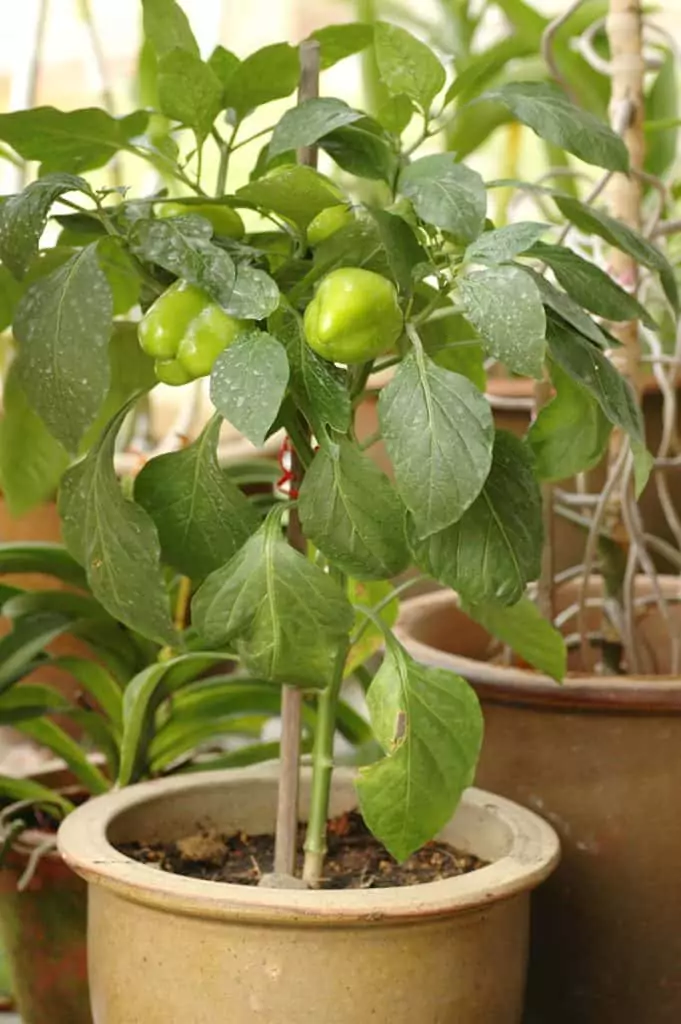
Choosing Container
Get a large container with drainage holes to start your bell peppers at the right track. The minimal deepness of the pot is ten to 12 inches for established plants. The width should be about the same.
When you first start seeds, you’ll need several small pots, but a permanent container should be large. You can even grow several plants in one large container!
Also, the color of the container is important. If you live in a warm climate, avoid black containers because those can attract too much warmth.
Avoid using the black color container if you’re growing bell pepper in a tropical climate. Don’t forget to drill the drainage holes to ensure good drainage.
Choosing Spot
Peppers are sun-lovers. They will thrive in full sun and develop the largest fruits when exposed to at least six hours of sunlight. But, too much direct afternoon sun can damage the plants. Ensure they are in semi-shade during the warmest parts of the day.
However, bell peppers are sensitive to winds, so ensure the location is sheltered.
Soil Type and Quality
Bell peppers aren’t too picky about the soil, but they grow best in sandy or loamy soil. You can also enrich the soil with organic matter to improve the nutritive value.
One option is to buy a ready potting mix that meets these requirements. The alternative is to mix the potting mix by yourself!
The soil needs to have excellent drainage to prevent waterlogging and root rotting.
Adding vermiculite or perlite will help with the drainage, and 5 gm of neem cake will prevent soil-borne problems.
Planting Bell Peppers Seeds
You shouldn’t pre-soak the seeds in water, as it may be counterproductive. If the seeds are wrinkled, you can wash them with hydrogen peroxide to prevent mold development.
The ideal soil temperature for seed germination is above 70 degrees Fahrenheit. Therefore, you can keep the soil in a sunny spot to warm it up.
Plant seed in the soil at 1/4-depth on a planting tray. Keep the soil warm and well moisturized. Some may recommend using a heating pad to help germination.
Once the seedlings appear, separate them and transplant them in the pots. You can start with smaller pots and repot the plants when the new foliage appears. You might have to do that several times until the plant is ready for a 12-inch pot as a final container.
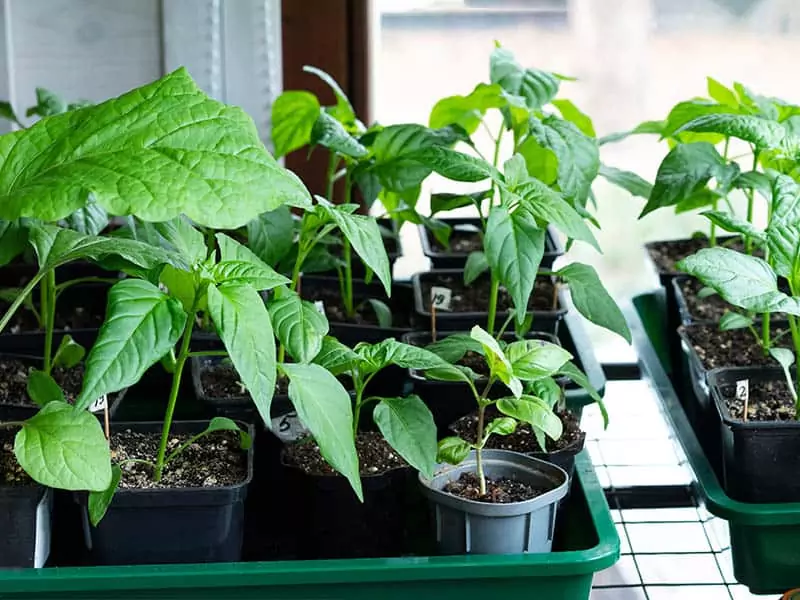
Put the pots on a sunny windowsill until the temperatures become warm enough so you can keep the pots outside!
If none of your windows are sunny enough, you can put the pots with bell pepper plants under LED growth lights and your plants won’t know the difference!
Watering
Bell pepper plants need regular watering. The soil needs to be slightly moist all the time. Therefore, check the soil frequently and adjust the watering. If you live in a warm climate, you might even have to water your pot bell peppers twice a day to ensure the plants get enough moisture!
The optimal amount is one to two inches of water per week. But, only water the plants at the base. Watering foliage brings the risk of fungal diseases!
Additionally, never allow your bell pepper plants to sit in standing water, as it can kill them.
Pruning
Here is an important step to include in your care for bell peppers. They may bloom soon after establishing. Don’t forget to pluck these early flowers, if you want to induce fruit production.
Removing flowers help the plant to direct energy into developing and remaining healthy.
Also, if you want to grow red peppers, pinch several new fruits and emerging flowers. It will help the plant utilize all its energy into maturing the existing fruits.
Bell peppers pruning technique explained.
Fertilization
Fertilization is an important step that will ensure your bell peppers have sufficient crops! However, you shouldn’t start fertilizing your plants as soon as they start developing.
Wait at least three to four weeks after planting to use fertilizer. Start with a lighter fertilizer, and then, as the plant develops, move on to the stronger one.
However, use a product with low nitrogen content after your plants develop fruits. Nitrogen might induce foliage production, instead of fruits. Once the fruit appears, choose fertilizers with more phosphorus, calcium and potassium to induce more fruit production.
What mulching and fertilizing do for bell peppers.
No Hand-Pollinating
One of the reasons why bell peppers are easy plants to grow is their self-fertilizing features. Therefore, hand-pollinating isn’t required, but you can shake the plants occasionally. It might help speed up the pollination process!
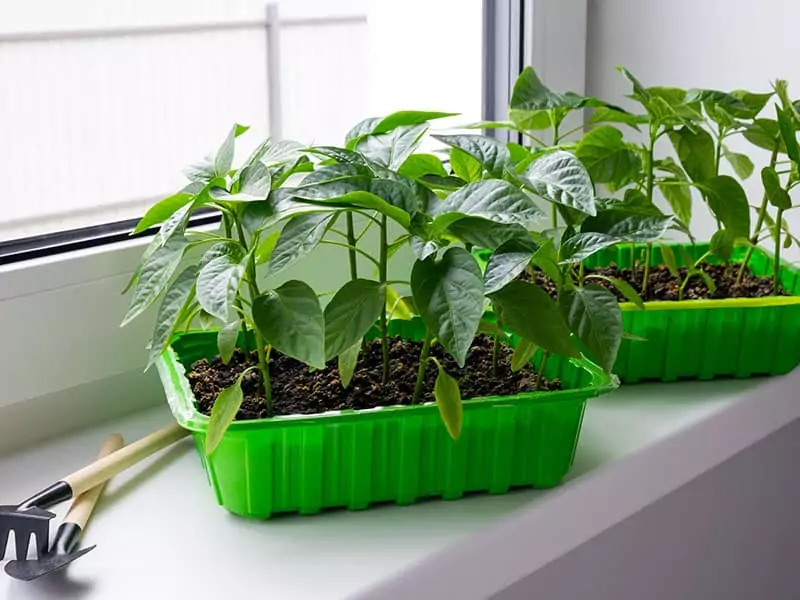
Stalking
If you do everything correctly, your bell pepper plants will grow vigorously. You might need stalking structures to support the growth. Tomato cages will do just fine.
The alternative is any stick or pole which you will put near the stem. Use the thin rope to tie the plant to the pole!
Harvesting
Harvesting bell peppers is nothing else than picking the plants when they grow to the preferred size. You can pick them green, or leave them on the plant for longer, until the fruit turn red.
If you want to pick green peppers, cut them with the stem. For red and fully ripe fruits, twist the fruit and it will fall off from the stem.
Ripe red peppers are sweeter and packed with more vitamin C, but green ones are crispier! Some varieties will turn purple, almost black, when left too long on the plant.
Storing Bell Peppers
Bell peppers don’t require any special treatment for storage. You can store them like any other fruit or vegetables – in the fridge.
You can put a paper towel with the peppers to prevent deterioration, so they can stay fresh for two weeks.
Cooked bell peppers remain fresh and tasty for three days in the fridge. But, the exact period depends on the cooking method.
If you want to enjoy the taste of your bell peppers for longer, you can make sweet pickling brine and keep the fruits tasty for much longer!
How To Grow Healthy Bell Peppers?
When you grow bell peppers in pots, your plants have fewer chances to suffer from infections transferred from other companion plants or fungal diseases caused by an untidy garden.
But, if you want to ensure the lowest chances possible for unhealthy plants, choose seeds that are resistant to problems.
You can specifically ask for resistant bell peppers seeds in your local nursery or look for codes such as IR: TEV. Additionally, the HR: BLS 1-3 label also means that seeds are resistant to viruses and bacterial leaf spots.
Alongside resistant seeds, using pots with drainage holes and not overwatering plants will help prevent a lot of issues with your bell peppers.
Pests and Diseases
Cutworms and aphids are the most common pests that can attack your plants and cause the most damage. Aphids cut the leaves, and cutworms can destroy young seedlings. To react in time, inspect your plants for any signs of damage on the foliage.
If you notice holes in the leaves, your plants might be under the attack of flea beetles.
You can treat most pests in the early stages of infestation with simple soap and water mixture!
Bell pepper diseases occur because of unsuitable growing conditions. For example, sunscald happens when your plants are exposed to too much bright sunlight. The symptoms are dry and papery foliage.
If the temperature and humidity around your plants are too high your plants can suffer from powdery mildew. Baking soda can be an effective solution against mildew alongside horticultural oil.
If you don’t use suitable fertilizer, your plant may suffer from calcium deficiency. Infrequent watering also causes ripe rot.
Most diseases aren’t very harmful to the plant, except for the Mosaic virus. There is no treatment for the plant and all you can do is destroy the infected bell peppers. Luckily, the mosaic virus is rarely an issue with bell peppers grown in pots. It mostly attacks plants from soil and garden plants are more prone to it.
FAQs
Are you ready to start growing your bell peppers in pots? If you still have some dilemmas or questions, please check the following section to find the answers.
For a Plate Full of Color, Grow Bell Peppers
Bell peppers are one of my favorite veggies. They taste delicious in all ways, but I prefer them fresh as quick, refreshing snacks.
Luckily, growing bell peppers isn't only suitable for people with large gardens in warm climates. You can easily grow them in pots indoors or outdoors!
Just keep them moist, fed, and warm, and your plants will reward you with delicious crops!
Have you tried container gardening for your veggies? What were some obstacles you came across? Please share your experience!
